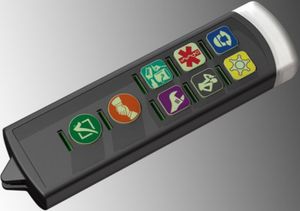To expedite responses to emergencies and other incidents requiring assistance, the Oakland-Alameda County Coliseum is using a communication system that includes active RFID tags provided by AeroScout and software from VenueSoft. The arena, home to the Oakland Athletics, Raiders and Golden State Warriors, is equipping 150 stadium employees with handheld RFID devices they can use to send alerts that specify the type and location of a problem.
Oakland-Alameda County Coliseum, which seats 62,000 people and hosts 100 events annually, had, like most other large stadiums, provided two-way radios to usher supervisors so they can report incidents during events. The radios let the supervisors speak to the coliseum’s dispatch center, located at the ground floor of the facility, in order to describe the nature of the difficulty and the location.
Dispatchers then contacted the necessary parties such as medical personnel, police or maintenance. This system, however, could be slow and inefficient. Not only did it take a certain amount of time for the supervisors to verbally confirm the nature of the incident and location, the stadium had difficulty tracking what happened after the call was first placed; who responded, how quickly and when the issue was resolved.
With the VenueSoft and AeroScout solution, much of this process is automated. Each head usher carries a VenueSoft VenueAlert handheld device—about the size and shape of a granola bar—equipped with an AeroScout T3i 2.4 GHz RFID tag, which communicates with standard (802.11) Wi-Fi access points deployed throughout the stadium. Each device has eight buttons. Six of them are designed to specify the type of incident—police, security, cleanup, repairs, medical or management. The other two are used to confirm that the requested personnel have arrived on the scene, and finally, that the trouble has been resolved, says Randell Wingate, chief operating officer at VenueSoft.
When an incident occurs, a head usher presses the appropriate button (for example, a police emergency). The device’s active RFID tag then sends its unique ID number, as well as the chosen type of service request to the nearest of 13 access points located in different zones of the coliseum. According to Wingate, the access points, each of which can read tags up to 330 feet away, were already installed at the coliseum as part of its existing Wi-Fi computer network.

“Whenever an usher presses one of the buttons, the device sends a message over the Wi-Fi network,” says Gabi Daniely, AeroScout’s vice president of marketing and product strategy. AeroScout software identifies the tag and passes that data to the VenueSoft software system, which then links the tag’s ID number with the access point’s location and the nature of the call and makes that information available on large computer screens in the command center.
Dispatchers use the VenueSoft system to select the necessary responding party, sending an immediate service request for that particular zone, which is identified by the unique ID number of the access point. The VenueSoft software presents the call in the form of an icon that blinks until the issue is addressed. The software system helps differentiate between a choice of responding parties, including multiple security companies and even two different law enforcement agencies (county sheriff and municipal police), depending on which side of the stadium the call comes from.
When the appropriate personnel arrive on the scene, head ushers press the “on scene” button. When the incident is resolved, they press the “done” button.
The VenueSoft software also provides business analytics to the stadium managers, allowing them to assess how quickly incidents were responded to and resolved. They can also look in real time at the computer screen to see if personnel have arrived on the scene. After the event, they can determine where in the stadium the supervisors placed the most calls for assistance, the nature of those calls and even the kinds of games and which opposing teams lead to a greater or fewer number of emergency calls. In that way they can better strategize the presence of ushers and security police during an event. “The purpose of the software is for management to look at trends. We have analytics tied into the software that will allow them to do that, and even to look at the system during the game,” Wingate says.
The coliseum first tested the system at an Oakland Raiders preseason football game in August, and has since used it again for two more games. The dispatch center received 300 to 400 calls during each event, Wingate estimates. He says he was able to hear the difference in the dispatch center when the AeroScout-VenueSoft system was in use instead of the radio.
“I think the biggest surprise was how quiet the dispatch room became,” Wingate says. “In the past if there was an incident, there were radios going, verbal commands. Now it’s being handled through the software.” However, supervisors, who are each in charge of eight ushers, still carry two-way radios for communications with other personnel in the stadium.
The VenueSoft AeroScout system is now being reviewed by seven other teams with the National Football League and two with the National Basketball Association, says Daniely.



